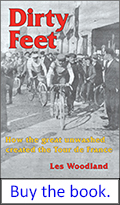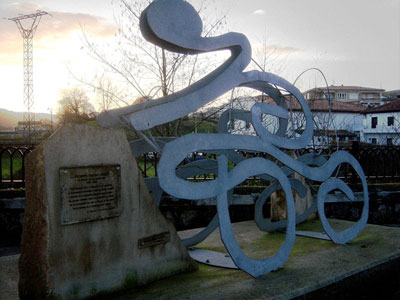

Vicente Trueba, "The Torrelavega Flea"
By Owen Mulholland
Back to Rider Histories index page

Les Woodland's book Dirty Feet: How the Great Unwashed Created the Tour de France is available as an audiobook here. For the print and Kindle eBook versions, just click on the Amazon link on the right.
Owen Mulholland wrote this in the 1980s:
Spanish riders have always been something of an enigma. Until fairly recently, Iberian racing was a world in itself, rarely penetrated by riders from the rest of the continent. The big exception is the Vuelta a España, which has hosted foreign riders since its inception in 1935. These foreigners often had a terrific fight to win Spain's national tour, and what was galling was that the home opposition frequently operated incognito the rest of the year.
Part of the answer is the date of the first Vuelta. This third biggest of continental tours (after those of Italy and France) got a thirty-year late start compared to the others. Anyone familiar with Spanish history can guess the reason. As poor as paysans in France, Belgium, Italy, etc. could be, eventually enough money for a bike could be scraped together by the family. Assuming the kid showed promise, he could look forward to financial support, even as an amateur, from some factory-sponsored club.
The average Spaniard was too poverty stricken to even dream of such a frivolous activity as bike racing. Every bit of energy was needed to survive. Stripped of its colonies, the vast wealth of the Americas squandered, Spain of the early twentieth century had to rely on its own meager resources to survive. A elite group kept an armlock on what little surplus there was. Anyone who hinted at objecting got a quick visit from the elite's army, who were just well-paid thugs.
In 1930 Henri Desgrange changed the Tour de France formula from trade teams to national teams. It proved to be just the inspiration needed to draw out the quasi-secret nucleus of good Spanish riders. Most struggled in the Tour, but a few had so much talent they adapted quickly.
Foremost among these were two brothers, Vicente and José Trueba. Vicente established the stereotype for Spanish riders: short, lean and very good in the mountains. He barely topped 100 pounds and his frame looked too big at 18 inches.

Monument to Vicente Trueba in the Spanish city of La Cavada, where Trueba is buried. Photo by Tony Rotondas
What wasn't small the kind of gear he could turn on the climbs. As with other riders of his power-to-weight ratio, he could get away with gears that would have broken the legs of a normal racer. He was at first indistinguishable from the pedaling mass of the peloton as the group began a climb. He would be content to follow the pace in a normal 42 x 24 gear.
By the way, riders in those days didn't use derailleurs. They had a single chainwheel and a double-sided hub, each side mounted with two cogs. To change gears, it was necessary to dismount, loosen the wing nuts, slide the rear wheel forward to get chain slack, move the chain over a cog, or take the wheel out and turn it around to get the desired ratio, pull the wheel back to get the proper tension, and tighten the wing nuts. Whew!
Most riders on long climbs must adopt a steady tempo. If necessary they will increase their speed gradually, but the real mountains give no chance to recover after violent efforts...unless you were the "Torrelavega Flea", as Trueba was known.

An undated photo of Vicente Trueba
When he tired of the, for him, boring tempo, his legs would go into electric motor mode for up to a minute at a time. If necessary, he could do this repeatedly. Most often, no one tried to follow. Once detached, he would jump off, move to a bigger gear, and proceed up the hill in a completely different manner.
With his body angled out over the front of the bike like some cherry picker, he would stomp away for up to half an hour. Not only could Trueba have done without a saddle in the mountains, he might have done with only half a pair of handlebars as well. An accident early in his career severed most of the nerves to his left forearm. He couldn't even carry a book in his left hand, but it didn't cramp his riding style.
Of course, Trueba wasn't a "complete" rider. Time trials, sprints, echelon riding; all were necessary evils for him. Still, he managed to finish sixth in the 1933 Tour de France, and win the Grand Prix de la Montagne competition, which was introduced that year.
Vicente also had great resistance, the ability to keep driving all day, and remember, it was literally "all day" back in the thirties. Stages of ten or more hours were common. Once away in the right combination, he could be a major force. While he would set the pace on the climbs, he could rely on his breakaway companions on the flats.
One famous example from the 1930 Tour de France: Trueba led over the Galibier Pass, followed at a modest pace by the race leader, André Leducq. Leducq crashed twice on the descent and was on the verge of abandoning the race before his teammates practically dragged him back onto his machine.
Meanwhile, Learco Guerra (Italian enemy number one), Vicente Trueba and a few others went ahead in a desperate effort to take as much time as possible. By the time Leducq was up and going, he was fourteen minutes down. It was one of the most epic pursuits in Tour history, and ultimately the French team won, Leducq winning the stage in a sprint! Trueba only regretted the paucity of climbs. Ninety kilometers of flat before the Aravis Pass meant his contribution was limited. A few more passes and Leducq might never have caught the break.
When Trueba retired to his hometown of Torrelavega, he invested his hard-earned money in a china factory and a restaurant. The combination left him wealthy and...fat. The legend will live as long as cycling, inspiration to every generation of Spanish cyclists; but the "Flea" was no more.








